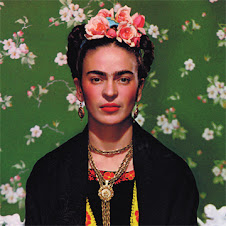Last Post for Final Presentation
So as I am wrapping up the final details of my powerpoint for tommorrow----I am coming to the conclusion that there might not be enough time to touch on the artist Kusama and Lisa Lau . The information I have gathered from the three interviews have proven to be more informative than I had imagined. My original intention was the discussion of repetitive mark making as a means of artistic impulse---I am very intrigued by the obsessive working habit of Kusama and Lau. Because Kusama voluntarily lives in a mental institution and it is common knowledge that she has regular hallucinations along with being extremely temperamental---I did not know how to approach my professors without them thinking that I was comparing them to some 'emotionally turbulent' Japanese artist without sounding offensive. After the first interview with Virginia Scotchie---I saw that her work does incorporate the methodology of repetition in her zealous creation of the form---but of course in a less compulsive sense as Kusama. She revealed a great deal of information surrounding her approach to process. This was when an epiphany occured---I am attracted to understanding the logistics needed to create the work. I think my intrigue about Kusmama and Lau was due to the idea that it is a rare occurrence to find work patterns such as these.
My questions began to sway towards asking more about their studio space---are there any 'rituals' that must take place inorder for them to feel comfortable enough to work---what sorts of events from their past help in the development of their current practices-In a way my questions were formed by their previous answer –Maybe the ‘punctum’ of their answer resulted in my next curiosity--and I eventually came around to asking questions pertaining to repetition. My second interview was with Bob Lyon. It was easier for me to develop questions for these two faculty since I have know them for two years, taken classes with them, and are constantly around their work especially when it comes to Virginia Scotchie. Lastly---unfortunately I was embarrassingly late on giving Sara Schneckloth her questionaire---her responses were so insightful. Its amazing to look at a person's work after having that sort of background knowledge-a change occurs. From the point when all three interviews were complete I began to analyze and apply our readings to each individual artist. For Scneckloth I began to see a correlation between her methodologies and that of Roland Barthes and Annette Kuhns. Barthes because of his referencing to the physical body---how to 'write the body'. How his physical body plays an important role in his writing--as well as the importance his studio is for his work. Kuhns due to her topic of memory ---how she enlist memory as a tool in her work. On an uncanny parallel Schneckloth relies on memory, the pysiological self, and the santity of her studio for her process. Pertaining to Bob Lyons approach to his work, it is reminiscent of Rene Descartes. Descartes acknowledges the importance of his academic upbringing, study of language as well as his travels. "After I had thus spent some years studying the bok of the world, and trying to aquire some experience, one day I resolved also to study within myself, and to use all the forces of my mind to choose the roads I should follow" (Descartes). Almost verbatum Lyons relayed the same message to me. The most crucial part about his process is the time that he has alone to reflect and for meditation. As far as Virginia Scotchie is concerned---her work is based upon this idea of what she has termed 'swiping' in my presentation I correlate this with Walter Benjamin's idea of remediation. Although this type of remediation does not involve an entire society---it pertains to the individual artist. Professor Scotchie being trained in production pottery---using the technology of the wheel--the technical skills she gained from her studies---and appling her own personal technology this swiping/grabbing from the object world. Her work is based on the everyday object. The irony about it is the fact that she will throw a tradition form on the wheel but distort it so that it looses function---this is a deliberate commentary on the technology of throwing. Scotchie's repetition comes with the practice of surface implements whether it be adding numerous knobs, spouts, or drilling out polka-dots---this is partially to deny the form traditional use--I would not consider it obsessive---as in Kusama's work.
In all three of the interviews I became aware that their treatment of studio space along with how they function within that environment was in fact an autobiographical impulse. Scotchie growing up with six other children -never being alone, tidiness reflects immediately in her studio. Both Lyon and Schneckloth prefer the solitarity of their space---the quiet time of self reflection/contemplation. The way in which these three artists view their final work---their use of tools---their idea of the viewer--materials--It became apparent to me immediately that all these aspects of the creator reveal an autobiographical impulse that is pertinent to the process.
Wednesday, December 5, 2007
Subscribe to:
Post Comments (Atom)




1 comment:
You suggest a distinction between a repetitive mark-making that is compulsive versus one that is more intentional (I'm thinking of the work "methodology," which implies a certain intentionality). Can you say something more about this (perhaps referring to either Kusama or Lau)?
Post a Comment